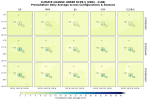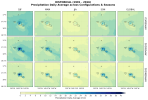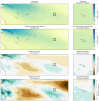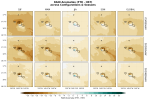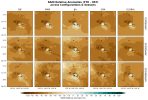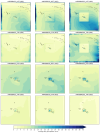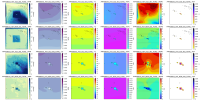Hello everyone,
I am reaching out with this post because I am questioning the coherence of my future simulations, and I hope that your experience and insights can help me understand the issue. Thank you in advance for your support in resolving what might be a significant problem.
After an initial analysis of my historical (HST) and future (FTR) long-term simulations, I noticed a drastic decrease in precipitation over Tahiti (as well as over the rest of the high-resolution domain) under future conditions. This issue appears across all three configurations I used. The most surprising observation is the near disappearance of the annual cycle (see attached figures: RAIN_SEASONAL_AVG_HST.png; RAIN_SEASONAL_AVG_FTR.png; ABSOLUTE_RAIN_ANOMALY_FTR_HST.png).
My first instinct was to check what CMIP5 models project for this region using the IPCC Interactive Atlas. However, the results and uncertainties are too broad to draw clear conclusions. My boundary forcing data are based on an adaptation of NCEP2 + CMIP5 MMM under RCP8.5 (as per Dutheil et al., 2019 - using Pseudo-Global-Warming approach).
To investigate further, I conducted the following checks:
At this stage, I am perplexed.
I understand that changing resolution—twice in this case, from 21 km to 7 km (d01), then from 7 km to 2.333 km (d02)—inevitably influences precipitation patterns. However, I expected large-scale forcing to have a dominant influence on domain-wide patterns. I would have been less surprised if Dutheil’s simulations exhibited a similar trend, but they do not.
I lack the experience to determine whether my simulations' behavior is plausible or if something is fundamentally wrong. That’s why I am seeking your expert advice.
Thank you very much in advance for your help!
P.S.: Note that I have also reached out to Dutheil et al. for their insights, but I’m eager to hear your perspectives on this matter as well.
I am reaching out with this post because I am questioning the coherence of my future simulations, and I hope that your experience and insights can help me understand the issue. Thank you in advance for your support in resolving what might be a significant problem.
After an initial analysis of my historical (HST) and future (FTR) long-term simulations, I noticed a drastic decrease in precipitation over Tahiti (as well as over the rest of the high-resolution domain) under future conditions. This issue appears across all three configurations I used. The most surprising observation is the near disappearance of the annual cycle (see attached figures: RAIN_SEASONAL_AVG_HST.png; RAIN_SEASONAL_AVG_FTR.png; ABSOLUTE_RAIN_ANOMALY_FTR_HST.png).
My first instinct was to check what CMIP5 models project for this region using the IPCC Interactive Atlas. However, the results and uncertainties are too broad to draw clear conclusions. My boundary forcing data are based on an adaptation of NCEP2 + CMIP5 MMM under RCP8.5 (as per Dutheil et al., 2019 - using Pseudo-Global-Warming approach).
To investigate further, I conducted the following checks:
- Input File Verification:
- wrfinput:
- d01 was generated from Dutheil's wrfout* using NDOWN (+ see comment for wrfbdy below).
- d02 was generated by interpolating d01 (using a Bash/NCO/CDO script).
- wrfbdy:
- d01 was also derived from Dutheil's wrfout* via NDOWN (no d02 required).
- I ensured that I did not mix up the source wrfout* files for NDOWN (confirmed by naming conventions: wrfout* PD (Present Day) ends with *00:00:00, while wrfout* CC (Climate Change) ends with *.nc).
- wrflowinp:
- d01 and d02 were generated from Dutheil’s wrfout* using a Bash/NCO/CDO script (containing only SST and VEGFRA variables).
- wrfinput:
→ No apparent issues here, but I welcome a second opinion.
- Namelist Consistency:
- I compared namelists between HST and FTR for all three configurations. The absence of differences (checked via
alias dify = "diff -y --suppress-common-lines") confirms consistency (no output from following command lines):
- I compared namelists between HST and FTR for all three configurations. The absence of differences (checked via
Code:
dify A4P0SBA33/rundir/A4P0SBA33_execute/19910201_19910228/namelist.input A4P0SBA32_FTR/rundir/A4P0SBA32_FTR_execute/19910201_19910228/namelist.input
dify A4P0SBD33/rundir/A4P0SBD33_execute/19910201_19910228/namelist.input A4P0SBD32_FTR/rundir/A4P0SBD32_FTR_execute/19910201_19910228/namelist.input
dify A4P0SBD33/rundir/A4P0SBKD32_execute/19910201_19910228/namelist.input A4P0SBD32_FTR/rundir/A4P0SBK32_FTR_execute/19910201_19910228/namelist.input- Trends in Dutheil’s wrfout* Data:
- Since my simulations end on May 31, 2016, I retrieved RAINC, RAINNC, and RAINSH for the last timestep of the PD and CC files on this date.
- I summed these three variables (total accumulated precipitation over the entire simulation) and divided by the number of days since the start (01/01/1980) to obtain daily averages for PD and CC.
→ Discrepancies appear minor over Tahiti (see CYRIL_PRECIPITATION_COMPARISON.png), much smaller than in my simulations. Moreover, my results show a negative anomaly, while Dutheil’s suggest a slight positive trend.
At this stage, I am perplexed.
I understand that changing resolution—twice in this case, from 21 km to 7 km (d01), then from 7 km to 2.333 km (d02)—inevitably influences precipitation patterns. However, I expected large-scale forcing to have a dominant influence on domain-wide patterns. I would have been less surprised if Dutheil’s simulations exhibited a similar trend, but they do not.
I lack the experience to determine whether my simulations' behavior is plausible or if something is fundamentally wrong. That’s why I am seeking your expert advice.
Thank you very much in advance for your help!
P.S.: Note that I have also reached out to Dutheil et al. for their insights, but I’m eager to hear your perspectives on this matter as well.

